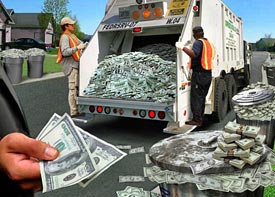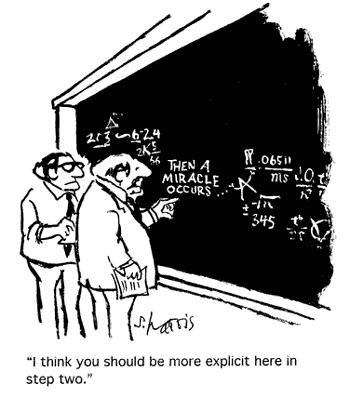Jan-Martin shares his thoughts on Bad Banks and the "Cash for Trash" model governments will use to buy or guarantee Bad Bank assets. The pre-packaged garbage, value unknown, may cost tax-payers around the globe trillions.
Bad Bank, Bad Pricing………
Courtesy of Jan-Martin Feddersen at Immobilienblasen
This conclusion from Calculated Risk sums it up
To be worth even 38 cents on the dollar, this must be a senior tranche. The lower tranches have absorbed most of the losses so far, and that is why S&P is currently valuing the bond at 87 cents on the dollar, but any higher default assumptions, and the value of this bond will plummet. I’m amazed, given that these are no money down 2nds that the loss severity is only 40 percent.
NYT (continued): The bond analyzed by S.& P. is just one of thousands that the government might buy or guarantee should it go forward with setting up a “bad bank” that would acquire $1 trillion or more of toxic assets from banks.
The value of these securities is based on the future cash flow they provide to investors. To determine that, traders have to make assumptions about the housing market and the economy: How high will the unemployment rate go in the coming years? How many borrowers will default? What will homes be worth?
The Standard & Poor’s group, Market, Credit and Risk Strategies, which operates independently from the company’s credit ratings business, has been studying troubled securities for investors and banks. The bond that is trading at 38 cents provides a vivid illustration of the dilemma in valuing these assets.
The bond is backed by 9,000 second mortgages used by borrowers who put down little or no money to buy homes. Nearly a quarter of the loans are delinquent, and losses on defaulted mortgages are averaging 40 percent. The security once had a top rating, triple-A.
Finally Joseph Stiglitz via Jesse´s Cafe Americain
Obama’s administration is moving closer to buying the illiquid assets currently clogging bank’s balance sheets and preventing them from boosting lending, people familiar with the matter said this week. That amounts to swapping taxpayers’ "cash for trash,” Stiglitz said yesterday
AMEN!
Source: Big Risks for U.S. in Trying to Value Bad Bank Assets, by VIKAS BAJAJ and STEPHEN LABATON, NYTimes



